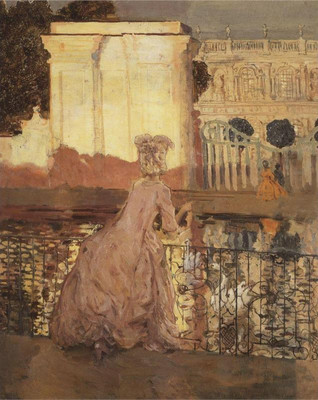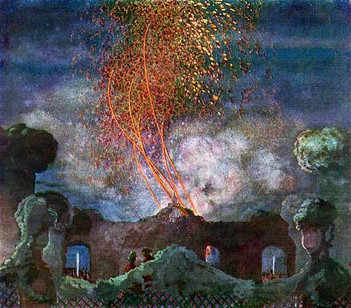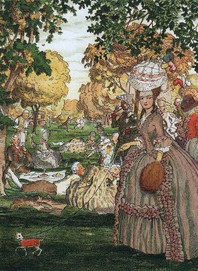Konstantin Somov - Gifted Gallery
- Lilium

- Jun 15, 2022
- 4 min read

Konstantin Andreyevich Somov, born November 30, 1869, was a Russian artist associated with the Russian magazine and the artistic movement, the Mir iskusstva.

Konstantin Somov was born in St. Petersburg. He was the second son of art historian and curator of the Hermitage Museum Andrei Somov. His mother, Nadezhda Konstantinovna, came from the noble family of the Lobanovs. She was well-educated and a musician. She instilled in her children a love of theater, music, and painting. The Somovs' had a large private collection of old prints, paintings and drawings. Young Konstantin dreamed of becoming an artist from a very young age
Somov first met future artist Alexandre Benois in the private Karl May School. Dmitry Filosofov also studied there, and Somov found a common language and even became friends with him. Later, Dmitry Filosofov was sent to Italy due to illness, and Somov, who had a hard time studying science, was taken from the school by his father. At the age of 20, Konstantin Somov entered the Imperial Academy of Arts. He studied there under Ilya Repin from 1888 to 1897.
While at the academy, Benois introduced him to Sergei Diaghilev, creator of Ballet Russes and painter and stage designer Léon Bakst. The three founded the World of Art to which Somov liberally contributed to. The World of Art became a prominent and influential Russian magazine which inspired a major art movement. He served on the editorial board and contributed illustrations and designs.

The artist's first major success came a year before graduation from the Academy. Somov and Benois spent the summer of 1896 at their dacha near Oranienbaum, in the village of Martyshkino. The landscapes and sketches he created there were highly praised by critics and colleagues. That year he also created illustrations for the works of Ernst Theodor Amadeus Hoffmann.
Studying in the academy was not easy for Somov, but in 1897 he successfully completed it and moved to Paris to continue his education at the legendary Académie Colarossi. Inspired by Watteau and Fragonard, he preferred to work with watercolours and gouache. For three years he worked upon his masterpiece, Lady in Blue, painted in the manner of 18th-century portraitists.

Somov was already a well-known artist by the time he ended his studies, and led a reclusive lifestyle. As evidenced by his letters from that period, loneliness was a burden for him. In the winter of 1899, Somov wrote to his friend and colleague Liza Zvantseva:
“Unfortunately, I still have no romance with anyone - flirting is, perhaps, very light. But I'm tired of being without romance - it's time, otherwise life goes away and youth, and it becomes scary. I am terribly sorry that my character is heavy, boring, gloomy. I would like to be cheerful, light, so that everything is knee-deep, amorous and rip-off. Only such people have fun, interesting and not scared to live!"
In 1910 when Somov was forty years old, he met eighteen-year-old Methodiy Lukyanov whom Somov nicknamed "Myth". He became Somov's closest companion. Methodiy settled with the Somovs and he became part of the family. Methodiy helped Somov run his household and organize exhibitions. He was also Somov's advisor and critic. In 1918, Somov painted a large portrait of Lukyanov sitting on the sofa in pajamas and a dressing gown. This portrait can be seen in the Russian Museum.


During the 1910s, Somov executed a number of rococo harlequin scenes and illustrations to the poems by Alexander Blok. Many of his works were exhibited abroad, and were particularly appreciated in Germany, where the first monograph on him was published in 1909.
Somov, like many of his contemporaries, greeted the revolution in Russia with enthusiasm. But as living conditions gradually deteriorated, his opinion soured. His apartment was nationalized, and he was later evicted. He struggled to retain the rights to his art. In December 1923, Konstantin Somov, together with the Russian Exhibition, went to the United States as an authorized representative of Petrograd. In the USA, he became close to the family of Sergei Rachmaninoff and painted portraits of the composer and his daughter.
He never returned to his homeland, choosing instead to settle in Paris, France, declaring Soviet Russia "absolutely alien to his art". In Paris, a community of Russian émigré artists grew, and Somov found inspiration in the "world of artists" with old friends Benois, Bakst and Serebryakova.
Around 1930, Somov met Boris Mikhailovich Snejkovsky: "...the twenty-year old young man who would inspire several of Somov's best later works. He would sit for straightforward portrait drawings, beautiful, mildly suggestive oil paintings, and he may have been the model for more erotic watercolours. The exact nature of his relationship with his model and friend is unknown."
Methodiy fell ill in the spring of 1931 with tuberculosis, which greatly distressed Somov. In letters to his sister in Russia, Somov wrote: “Every minute of my life is now torment - although I do everything I need to - eat, talk with visitors, even work a little - the thought of Methodius and the upcoming separation does not leave me. Now I absorb into myself his face, his every word, knowing that soon I will not see him again "..." Yesterday, lying on a mattress, on the floor by his bed, I tried to pray mentally - it's me! God, if you exist and care about people, prove, save Methodius to me, and I will believe in you! But it's all in vain." Somov remained with Methodiy in Paris until Myth's death. Methodiy's last words to Somov were: "Kostya ... goodbye."

Konstantin Somov died May 6, 1939, aged 69, in Paris. Somov was buried in the Sainte-Geneviève-des-Bois Russian Cemetery, south of Paris. On June 14, 2007, Somov's landscape "The Rainbow" (1927) was sold at Christie's for US$7.33 million, a record for a work at an auction of Russian art.
Somov's diary (Dnevik) for the years 1917–1927 was published in Russian by art historian Pavel S. Golubev (Dmitrii Sechin publishing house, Moscow) in 2017, 2018 and 2019; the three volumes total over 2100 pages.































































































































































































Comments